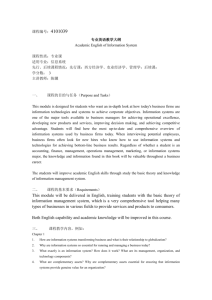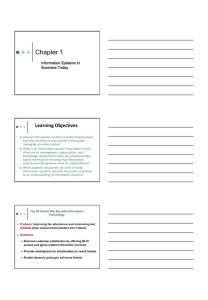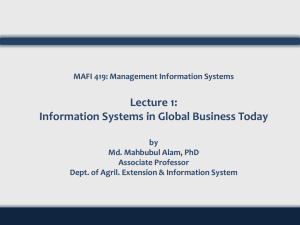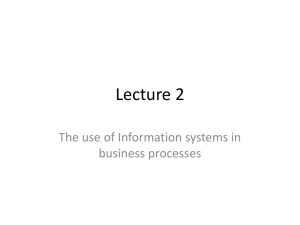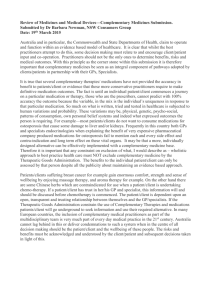INFO1400 Chapter 1 Review Questions 1. How are information
advertisement
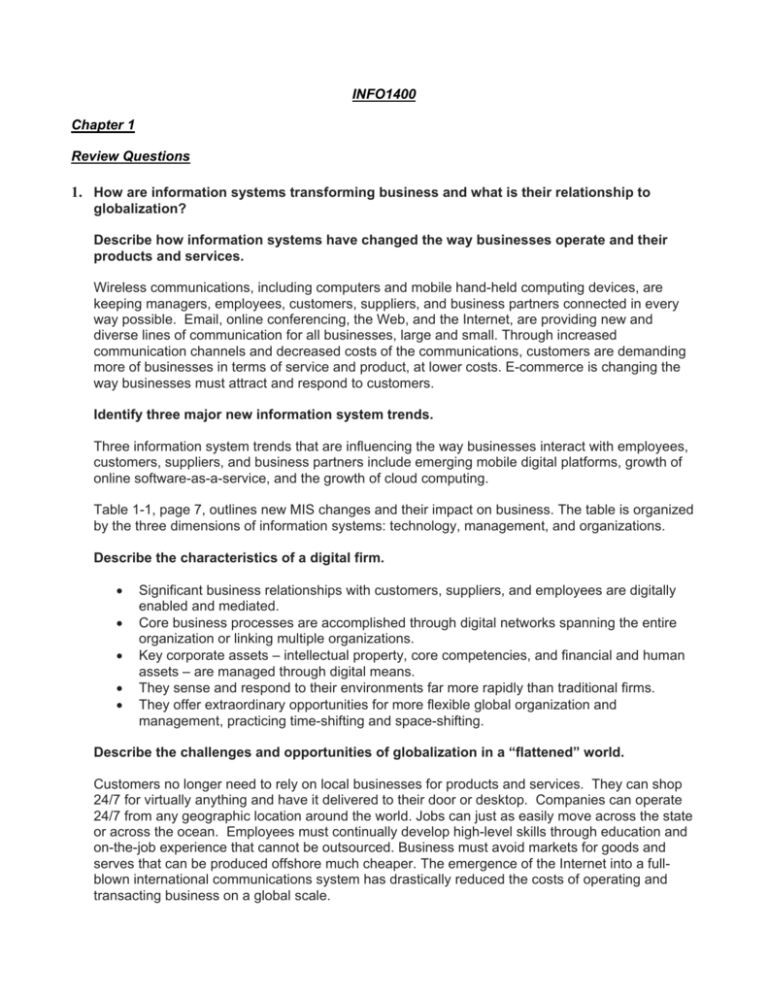
INFO1400 Chapter 1 Review Questions 1. How are information systems transforming business and what is their relationship to globalization? Describe how information systems have changed the way businesses operate and their products and services. Wireless communications, including computers and mobile hand-held computing devices, are keeping managers, employees, customers, suppliers, and business partners connected in every way possible. Email, online conferencing, the Web, and the Internet, are providing new and diverse lines of communication for all businesses, large and small. Through increased communication channels and decreased costs of the communications, customers are demanding more of businesses in terms of service and product, at lower costs. E-commerce is changing the way businesses must attract and respond to customers. Identify three major new information system trends. Three information system trends that are influencing the way businesses interact with employees, customers, suppliers, and business partners include emerging mobile digital platforms, growth of online software-as-a-service, and the growth of cloud computing. Table 1-1, page 7, outlines new MIS changes and their impact on business. The table is organized by the three dimensions of information systems: technology, management, and organizations. Describe the characteristics of a digital firm. Significant business relationships with customers, suppliers, and employees are digitally enabled and mediated. Core business processes are accomplished through digital networks spanning the entire organization or linking multiple organizations. Key corporate assets – intellectual property, core competencies, and financial and human assets – are managed through digital means. They sense and respond to their environments far more rapidly than traditional firms. They offer extraordinary opportunities for more flexible global organization and management, practicing time-shifting and space-shifting. Describe the challenges and opportunities of globalization in a “flattened” world. Customers no longer need to rely on local businesses for products and services. They can shop 24/7 for virtually anything and have it delivered to their door or desktop. Companies can operate 24/7 from any geographic location around the world. Jobs can just as easily move across the state or across the ocean. Employees must continually develop high-level skills through education and on-the-job experience that cannot be outsourced. Business must avoid markets for goods and serves that can be produced offshore much cheaper. The emergence of the Internet into a fullblown international communications system has drastically reduced the costs of operating and transacting business on a global scale. 2. Why are information systems so essential for running and managing a business today? List and describe six reasons why information systems are so important for business today. Six reasons why information systems are so important for business today include: (1) Operational excellence (2) New products, services, and business models (3) Customer and supplier intimacy (4) Improved decision making (5) Competitive advantage (6) Survival Information systems are the foundation for conducting business today. In many industries, survival and even existence without extensive use of IT is inconceivable, and IT plays a critical role in increasing productivity. Although information technology has become more of a commodity, when coupled with complementary changes in organization and management, it can provide the foundation for new products, services, and ways of conducting business that provide firms with a strategic advantage. 3. What exactly is an information system? How does it work? What are its management, organization and technology components? Define an information system and describe the activities it performs. An information system is a set of interrelated components that work together to collect, process, store, and disseminate information to support decision making, coordination, control, analysis, and visualization in an organization. In addition to supporting decision making, information systems may also help managers and workers analyze problems, visualize complex subjects, and create new products. List and describe the organizational, management, and technology dimensions of information systems. Organization: The organization dimension of information systems involves issues such as the organization’s hierarchy, functional specialties, business processes, culture, and political interest groups. Management: The management dimension of information systems involves setting organizational strategies, allocating human and financial resources, creating new products and services and re-creating the organization if necessary. Technology: The technology dimension consists of computer hardware, software, data management technology, and networking/telecommunications technology. Distinguish between data and information and between information systems literacy and computer literacy. Data are streams of raw facts representing events occurring in organizations or the physical environment before they have been organized and arranged into a form that people can understand and use. Information is data that has been shaped into a form that is meaningful and useful to human beings. Information systems literacy is a broad-based understanding of information systems. It includes a behavioral as well as a technical approach to studying information systems. In contrast, computer literacy focuses primarily on knowledge of information technology. It is limited to understanding how computer hardware and software works. Explain how the Internet and the World Wide Web are related to the other technology components of information systems. The Internet and World Wide Web have had a tremendous impact on the role information systems play in organizations. These two tools are responsible for the increased connectivity and collaboration within and outside the organization. The Internet, World Wide Web, and other technologies have led to the redesign and reshaping of organizations. They have helped transform the organization’s structure, scope of operations, reporting and control mechanisms, work practices, work flows, and products and services. 4. What are complementary assets? Why are complementary assets essential for ensuring that information systems provide genuine value for an organization? Define complementary assets and describe their relationship to information technology. Complementary assets are those assets required to derive value from a primary investment. Firms must rely on supportive values, structures, and behavior patterns to obtain a greater value from their IT investments. Value must be added through complementary assets such as new business processes, management behavior, organizational culture, and training. Describe the complementary social, managerial, and organizational assets required to optimize returns from information technology investments. Table 1-3 (page 27) lists the complementary social, managerial, and organization assets required to optimize returns from information technology investments. Here are a few of them: Organizational assets: Supportive culture that values efficiency and effectiveness Appropriate business model Efficient business processes Decentralized authority Managerial assets: Strong senior management support for technology investment and change Incentives for management innovation Teamwork and collaborative work environments Social assets: The Internet and telecommunications infrastructure IT-enriched educational programs raising labor force computer literacy Standards (both government and private sector) 5. What academic disciplines are used to study information systems? How does each contribute to an understanding of information systems? What is a sociotechnical systems perspective? List and describe each discipline that contributes to a technical approach to information systems. A technical approach to information systems emphasizes mathematically-based models to study information systems and the physical technology and formal capabilities of information systems. Students should know the differences between computer science (theories of computability, computation methods, and data storage and access methods), management science (development of models for decision making and managerial practice), and operations research (mathematical techniques for optimizing organizational parameters such as transportation, inventory control and transaction costs). List and describe each discipline that contributes to a behavioral approach to information systems. A behavioral approach to information systems focuses on questions such as strategic business integration, behavioral problems of systems utilization, system design and implementation, social and organizational impacts of information systems, political impacts of information systems, and individual responses to information systems. Solutions to problems created by information technology are primarily changes in attitudes, management, organizational policy, and behavior. Describe the sociotechnical perspective on information systems. A sociotechnical perspective combines the technical approach and behavior approach to achieve optimal organizational performance. Technology must be changed and designed to fit organizational and individual needs and not the other way around. Organizations and individuals must also change through training, learning, and allowing technology to operate and prosper.
